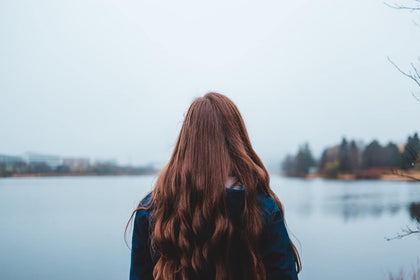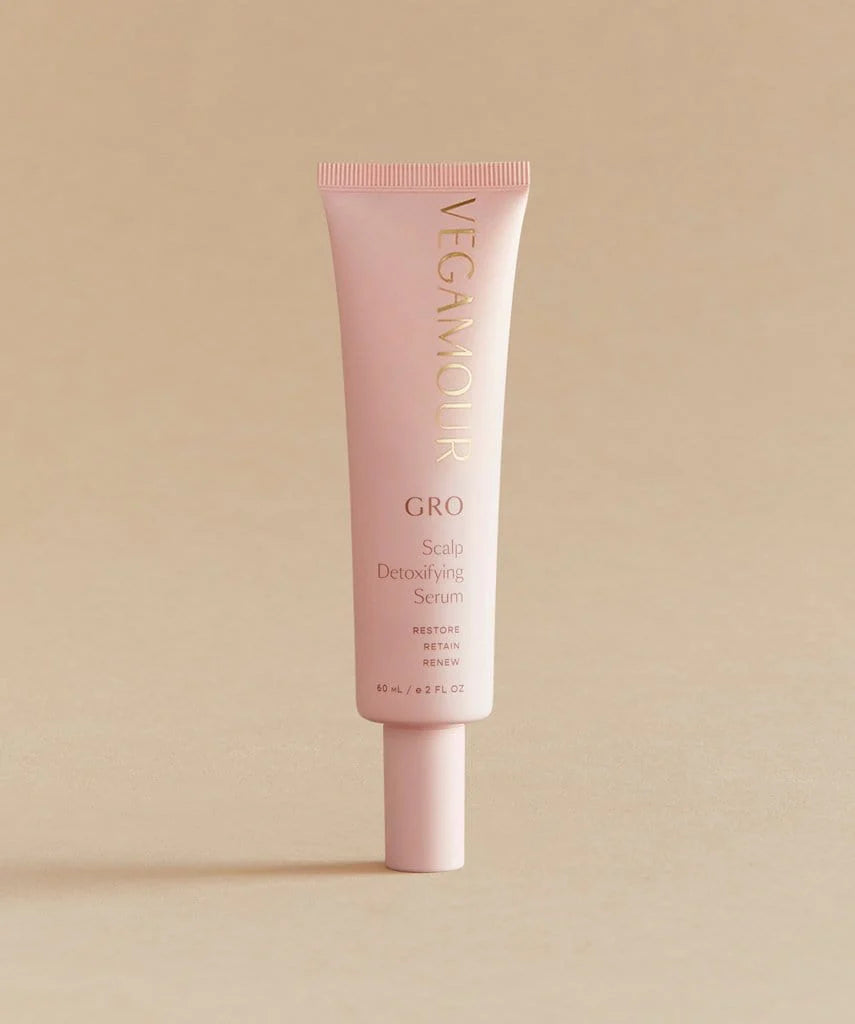Dandruff, in its more serious form — aka seborrheic dermatitis — and dry scalp can both cause flakes to fall from the scalp. While both skin conditions have similar symptoms, differences do exist.
If you’ve noticed flakes camping out around your hair follicles or falling onto your shoulders, it's time to find out which skin condition you may have and get info on the best products to combat dandruff and dry scalp.
#include-related-slider#
What Is Dandruff?
Starting at puberty and becoming less prevalent after age 50, dandruff affects about 50% of the world’s population, with men experiencing it more than women. It is characterized by patches of small, oily grey or white flakes in the hair and an itchy scalp. If you notice white flakes accumulating on your scalp, in your hair or on your clothes, you may have dandruff.
A more severe (and far less common) form of dandruff is known as seborrheic dermatitis. Seborrheic dermatitis most often occurs in the first three months of life (known as cradle cap), during puberty or during adulthood, where it’s most prevalent between ages 40 and 60. Like dandruff, it affects men more often than women, but only about 3% of teens and adults have SD.
Scientists describe seborrheic dermatitis and dandruff as “a continuous spectrum of the same disease.” Research indicates the same causes for each, but the symptoms of seborrheic dermatitis extend beyond those of dandruff.
In the case of seborrheic dermatitis, flakes often appear greasy and yellow. In addition, there's visible inflammation of the skin. And, unlike dandruff that is confined to the scalp, seborrheic dermatitis can extend to the areas around the mustache and beard, eyebrows, ears and chest. If you notice patches of redness, flaking, and oily or dry scales, especially beyond the scalp, this could be seborrheic dermatitis.
Seborrheic dermatitis has also been associated with illnesses, such as Parkinson’s disease and epilepsy, disorders like Down syndrome, and even with treatments for other skin conditions like psoriasis.
Research indicates multiple factors contribute to dandruff and its more severe form, seborrheic dermatitis.
- Sebum: Dandruff only appears in areas with high amounts of sebum: a thick, oily substance produced by sebaceous glands in the skin. Stress and hormones affect how much sebum is released, which impacts the occurrence and severity of dandruff.
- Malassezia: This group of yeast-like fungi is naturally found on the skin. In fact, almost all humans have Malassezia globosa — the species most commonly associated with dandruff. Malassezia is found on sebum-rich areas of the body. Why? Sebum contains fatty acids that the Malassezia fungus can break down and use to multiply. When the Malassezia consume the saturated fatty acids they need, they leave behind unsaturated free fatty acids, which can penetrate the skin and then cause irritation and flaking.
- Susceptibility: You might have noticed that sebum and Malassezia are normal parts of the human body, but only about half the population has dandruff. How is that possible? It turns out, the fatty acids that can penetrate the skin and cause flaking don't always do that. But research has yet to explain why. However, we do know that certain circumstances, including hormone imbalances, a weakened immune system, heightened stress and infrequent shampooing, can cause Malassezia to grow unchecked and increase the risk of dandruff.
While dandruff and seborrheic dermatitis are chronic conditions, they are not contagious and can be treated. In addition to itching, flaking, irritation and scalp or hair pain, the skin conditions can have a significant negative impact on self-esteem, especially in the case of seborrheic dermatitis, which often appears on the face. So, it’s important to find a scalp treatment that helps you look and feel your best.
Shop: GRO Balance & Boost Kit
What Is Dry Scalp?
When dry scalp occurs, you'll notice small white flakes that feel dry — not large or oily dandruff flakes. While both dandruff and dry scalp cause itching, patients with dry scalp may also feel tightness in the dry skin on the head.
Possible causes of dry scalp include:
- Dry weather conditions
- Contact dermatitis from hair products
- An unbalanced diet
Unlike dandruff, which shows no change based on climate, dry scalp often results from harsh, dry weather. Many patients experience the condition seasonally during cold winter months. When the body experiences a lack of moisture, the skin cells on the scalp (and other parts of the body) become irritated, which causes flaking.
Another possible cause of a flaky, dry scalp (especially if you have sensitive skin) is contact dermatitis: an allergic reaction to a substance that comes into contact with the skin. In this case, avoiding the irritant should allow the flaking to resolve. However, you may need to see a doctor for medication to reduce itching.
Diets lacking in certain fats, vitamins and minerals can also prevent skin from staying hydrated and lead to dry scalp or dry skin elsewhere on the body.
Also: How to Moisturize Your Scalp
Anti-Dandruff Shampoo
Both antifungal and steroidal anti-inflammatory treatments are successful treatments for dandruff. However, researchers caution against steroids, except in severe cases, due to adverse side effects. When fighting off dandruff, remember it’s a chronic issue, so continual treatment is necessary. Therefore, it’s important to find treatment options that are easy to use and have minimal side effects.
If you have mild dandruff, start by using a gentle shampoo every day to prevent the buildup of oils and skin cells. If this method does not reduce dandruff, several medicated shampoos are available over the counter.
The medications in dandruff shampoos vary, so you may need to try different options to find the best scalp treatments.
- Coal Tar Shampoo: This treatment decreases the number and size of skin cells, reducing how often cells die and flake. It can cause discoloration in lighter hair and sensitive skin in sunlight.
- Ketoconazole Shampoo: This formula aims to kill off the fungus on your scalp that causes dandruff. It’s generally used only twice a week but requires 5 to 10 minutes on the scalp. It's available over the counter or in a stronger version with a prescription.
- Salicylic Acid Shampoo: This shampoo helps eliminate scaling skin. It loosens flakes and lets them be rinsed away.
- Selenium Sulfide Shampoo: This treatment contains an antifungal to fight Malassezia. Be sure to rinse from hair thoroughly to avoid discoloration to the hair and scalp, especially if you have a lighter hair color.
- Tea Tree Oil Shampoo: One study showed that 5% tea tree oil shampoo was effective in the treatment of dandruff due to its antifungal properties.
- Zinc Pyrithione Shampoo: Perhaps the best-known anti-dandruff shampoo falls into this category. It treats fungal infection with properties that fight both fungus and bacteria.
If over-the-counter anti-dandruff shampoos do not ease your condition after several weeks, contact your doctor to discuss prescription-strength shampoo. Doctors can also prescribe a steroid lotion to ease symptoms.
Shop: Best-Selling Dandruff Products
Shampoos for Dry Scalp
Just like with dandruff, using a harsh shampoo can worsen dry scalp. Use a gentle moisturizing shampoo and avoid formulas made for oily hair. Showering with slightly cooler water (warm, not hot) may also offer relief for dry skin.
Unlike with dandruff, where shampooing every day helps by counteracting excess oil production, you should not shampoo daily if you have a dry scalp. It will strip oils away and cause more dry skin. However, some of the same medicated shampoos may help alleviate dry scalp. Search for hair care products containing zinc to reduce inflammation. Or find a shampoo with salicylic acid that exfoliates and removes dead skin cells.
Alternative Treatments for Dandruff vs. Dry Scalp
Shampoos can be effective hair care products for fighting dandruff and dry scalp, but there are many alternative treatments and lifestyle changes you can try as well.
Focus on Scalp Health
Try GRO Scalp Detoxifying Serum to safely reduce sebum production and dandruff-causing fungi. This vegan, color-safe scalp serum gently removes buildup, soothes irritation and restores balance to the scalp.
Shop: Healthy Scalp Products
Treat Yourself to a Scalp Massage
Stimulate the scalp by gently moving your scalp massager in circular patterns. This can help work in your favorite scalp treatment and alleviate itching.
Take Time to Relax
Increased stress can worsen existing conditions, including dandruff and dry scalp. Exercise, rest, practice yoga — however you relax, it will help improve your overall wellness.
Go Natural
Hairstyling products take a toll on your tresses. They build up on your scalp and cause more oil (bad for dandruff) or dry out your hair with alcohol (bad for dry scalp). Limiting products and the use of heat styling tools in your hair care routine can give your locks time to recover.
Get the Nutrients You Need
Overall health begins with a healthy diet. To prevent dandruff, be sure to get enough zinc and B vitamins. For dry scalp, also add omega-3s and plenty of water to stay hydrated.
See a Dermatologist
Whether you have dandruff, dry scalp, scalp psoriasis, another skin condition or you could just use a scalp detox treatment, a medical professional can diagnose your symptoms and help you find relief. For best results, reach out to your dermatologist for guidance.
#include-related-slider#
More From VEGAMOUR
- Shop: GRO Dry Shampoo 3-Pack
- The Dangers of Brazilian Blowouts Explained
- What Is Forest Bathing? How to Relieve Stress Outdoors
- 6 Signs You Need a Scalp Detox




















